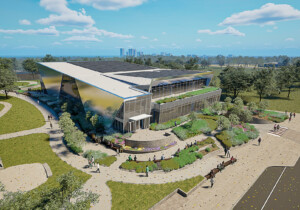The Historic Chicago Bungalow Association (HCBA) launched the #StopThePop campaign to raise awareness and publicly denounce a recent tendency in which homeowners and developers build “incompatible” full second-story additions atop Chicago’s iconic bungalows. The HCBA believes that such “bad” additions, or “pops,”
destroy the architectural character of the homes and the collective harmony of the surrounding streetscape.
After the rollout of #StopThePop campaign last June, what actually popped to the surface was less a discussion about preserving architectural landmarks, and more a social media-facilitated debate regarding what constitutes good taste.
The HCBA reports that, with over 80,000 bungalows in Chicago, the building typology constitutes about one-third of the city’s single-family housing stock. Largely built between 1910 and 1940 in dense neighborhood clusters that arc around the city center, these narrow, one-and-a-half story buildings originally provided modest, efficient,
and inexpensive housing options for many young families. Often purchased with unfinished attics, a growing family might convert the partial second story attic into a spare bedroom later on.
After a century, the Chicago Bungalow remains as appealing as ever. Clad in everyday brick, occasionally fenestrated with Prairie-style stained glass, and approached via an off-center entry porch, the bungalow is both inviting and quotidian. On its own, a bungalow may not command architectural presence. But when arrayed neatly along a side street, collections of bungalows lend a strong architectural identity to a Chicago streetscape.
While the HCBA lacks legal authority to regulate construction, its #StopThePop petition aims to educate the public on “‘good’ versus ‘bad’ additions,” provide access to qualified architects, and to call upon city officials to address the issue. Acknowledging that “changing lifestyles pose new and challenging living requirements” to historic bungalows, the HCBA provides a 27-page design guidelines booklet to ensure “sensible” bungalow renovations. While the guidelines are progressive in regards to interior renovations, stressing the rearrangement of walls over additions, upgrading mechanical systems to more energy-efficient alternatives, and increasing R-values, it favors conservative exterior updates. Its main directive is to set back second story additions at least 20 feet from the street to conceal their visibility as completely as possible.
Developers that are engaged in bungalow renovation projects, such as Welcome Home Chicago Properties, rebut that they are simply satisfying the expanded space and lifestyle needs of their clients. In a similar spirit, a number of voices have emerged on social media articulating the design freedom that property ownership provides. As cheekily summarized up by one reader’s comment on a Chicago Tribune online article covering the Bungalow battle, “If someone wants to live in an ugly house that should be their choice.” For city-dwellers like this commenter, the #StopThePop campaign questions who should have the right to govern our collective aesthetic sensibilities.
While the City of Chicago Department of Buildings has yet to respond to HCBA’s petition, it is energizing to see the public voices on both sides of the debate step into a conversation about what our cities look like and what aesthetics mean within our neighborhoods.










